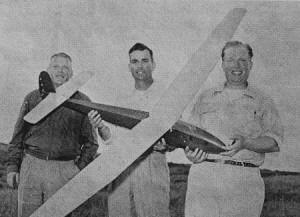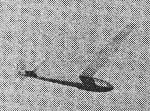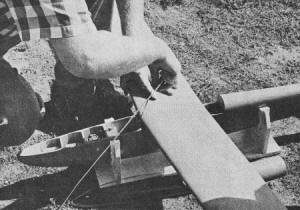|
I did not bother to
look up what the world record endurance flight length is for an R/C glider as of
this writing, but in December 1956 when this article appeared in the first
edition of American Modeler magazine, a team of three modelers did 8
hours, 34 minutes and 21 seconds at Torrey Pines, California. That would be an
amazing accomplishment with today's equipment, but these guys did it with a
vacuum tube receiver and an escapement mechanism driven by a twisted rubber band
- rudder-only! No elevator control, no flaps or speed brakes, no gyroscopic
stabilization, no proportional rudder deflection. It was left, center, or right
rudder, with no in-flight trim. More than a year of preparation went into
designing the aircraft, and the electromechanical equipment. Running a receiver
for so long on the pair of batteries (low voltage for heater elements and
signals and high voltage plate bias supply) required minimal current draw, and
packing enough turns of rubber to last the entire flight was no simple task. A
minimum number of turns were used in order to preserve turns. Not having to deal
with the vibration of an engine helped with circuit reliability. Even the
transmitter needed to be fine tuned to guarantee performance over the time
period. Mechanical stop watches timed the flight.
World's Radio Control Endurance Record

World record team members Don Cone (left), Dr. Bob Chase (center),
and Ed Phillips (right).
West Coast Modeling - 8.5 Hours Plus!
Exclusive story on how the new world's radio control endurance record
was set in California
 What does it take to exceed an established
F.A.I. world's record for R/C gliders? Well - it takes a lot, first one must
prepare for the attempt, in the case of Don Cone and Dr. Bob Chase, this meant about a year of
preparation since they were after the R/C glider record and the time was already
a staggering 3 hours and 28 minutes. What does it take to exceed an established
F.A.I. world's record for R/C gliders? Well - it takes a lot, first one must
prepare for the attempt, in the case of Don Cone and Dr. Bob Chase, this meant about a year of
preparation since they were after the R/C glider record and the time was already
a staggering 3 hours and 28 minutes.
Don went after the receiver and plane equipment while Dr. Bob went after the
soaring model and the flying experience. Don ran through several receivers, and
escapements and countless hours of testing in mock ups to simulate flight conditions.
Bob constructed several gliders, practiced several times a week, built up many hours
of flying experience both at Palos Verdes and at Torrey Pines, San Diego. Don ended
up with a 3 tube receiver and a geared and a simple escapement which passed a continuous
operating test of over 31 hours; Bob ended up with 5 gliders, one for every degree
of wind conditions from 3 mph to 35 mph. They then had to arrange for a sanction,
the directing official and the other necessary officials, get all the equipment
together, etc.
As it turned out, the attempt was delayed for a week due to the writer's trip
to Japan for the Air Force but turned out for the good for at 9:51 and 9:53 AM Pacific
Standard time, the two gliders were launched at Torrey Pines, California, one to
land after 1 hour and four minutes, the other late in the evening after 8 hours,
34 minutes and 21 seconds. Dr. Bob Chase in complete control for the latter flight
was one really tired model builder. This performance has been presented with all
necessary forms to the A.M.A. and the F.A.I.
Here is the complete history - both Don and Bob belonged to the Pasadena Club
along with Russ Johnson, etc. About two years ago they became interested in R/C
gliders. Both were old Wakefield and Nordic men with power as a side line. About
a year ago they became enthused to the point that they were determined to fly a
glider longer than anyone else.

Assembling the seconds record setting glider for its 8 hour,
34 minute and 21 second flight.
Don, in the meantime, moved to Palo Alto but that didn't stop them. Don went
to work on the equipment with gusto. It wasn't till March of this year that he decided
he had something; the 3 tube receiver and home brew escapement had operated for
31 hours 25 minutes, the escapement had tuned 2125 revolutions. Don figured this
lash-up had received more than 13,000 signals. Interesting, too, is the battery
drain throughout the test. A battery was 1.340 at start and 1.000 at the end, B
battery 46.0 at start and 40.0 at the end, the escapement battery was 2.620 and
2.200, not too much at any time.
The actual voltages after the record flight showed the filament at 1.23 V, escapement
2.7 no load and 2.55 under load, B at 42 V idle and 40.5 under load, still plenty
of juice left.
Dr. Chase was equipped with 3 gliders at the site after a check with the weather
man the two ships flown, both with a 11 oz. wing loading, and a "penetrator"
with a 14 oz. wing loading. Although the two that were flown had the same wing loading,
the difference between the two was like comparing the flight of the 1-23 and the
Kern-Maxey; in fact, the glider which flew the fastest looked very much like the
Kern-Maxey, low dihedral, V-tail and all, biggest difference was speed and penetration.
Bob flew the slower ship giving Don the penetrator, the faster ship required more
control use since it flew the circuit faster.
Transmission was in the capable hands of Ed Phillips,
who has a master's degree in Electro Engineering from Cal Tech and is currently
employed at Hughes Aircraft in the Radar Development Section. Ed had all this down
pat. The transmitters used were both housed in a single cabinet and dynamotor powered
with a car battery as supply plus a standby battery. Details are as follows: 27.255
transmitter: 6AR6 oscillator, 5763 final 5.00 watts input, 1/4 wave antenna; 52.24
mc transmitter: 12BY7 oscillator, 5763 final and a 1/2 wave coaxial antenna with
15 watts input.
Checkout of transmission was with a field strength meter for each frequency plus
distance checks with both the antenna disconnected then long range with antenna
connected. Due to the limited turns available on the escapement motors each keyed
signal was monitored with a counter so that at any time Bob knew how many turns
of the rubber motor he had used. Each half hour Ed checked the batteries with a
hydrometer for dielectric strength - a real thorough and very practical engineer.
The log for the entire day goes as follows: We get out of the sack at 0600; leave
for Torrey Pines at 0710; arrive at 0930, the first on hand; at 0945 comes Russ
Johnson and wife; 1000, Dr. Bob Chase and wife; 1005, Don and Ed Phillips make their
appearance while Bob is unloading the ships; 1020, xmtrs hooked up, planes assembled;
1025, start checkout; 1045, checkout complete, everything OK at 3/8 mile; 1051,53
mc ship launched by Bob, Don at the controls, lift is present for the ship soars
up; 1053, Russ Johnson launches Bob's 27 mc ship, stop watch in one hand, ship in
the other, lift fair, hazy overcast; 1114, Bob makes passes for pictures, counter
shows 50 signals used or 25 turns of the motor; 1151, 200 signals, 100 turns or approximately 100 turns for first hour; 1154, wind shifts about 30 degrees, lift
lessens, 1st ship launched lands, Chase's model is down to 150 feet from the water
seeking lift, fights for altitude about 3/8 mile from the xmtr, lift at the point
is slight, model gains altitude slowly; 1201, wind starts shifting back, lift increases,
model is now about 250 feet above us or 650 feet over the ocean, we all breathe a little
easier; 1210, changed batteries on xmtr to recheck new battery under load, everything
going smooth; 1221, rewound all 5 stopwatches; 1223, Coast Guard helicopter coming
up the beach on patrol, hope it swings out to sea around us, they see us and swing
out; 1225, Cone in the air again on 53 mc; 1230, food, Mrs. Chase serves us an appetizing
lunch of potato salad, eggs, chips, pickles, sandwiches and Coke! 1253, Chase completes
2nd hour conserving turns, flies parallel to cliffs for about 3/8 mile, swings out
to sea for about 1/2 mile, comes in to the cliffs again, using as few controls as
possible; 1415, both ships now high overhead, lift much improved; 1553, 1012 signals
sent, 506 turns of escapement motor used, approx. 1600 turns left; 1648, 1st battery
hydrometer reading 1150, changed batteries as 1200 signals sent; 1657, Cone down
again as lift decreases, Chase fights to maintain altitude; 1753, 1430 signals sent,
715 turns used; 1850, wound all watches again, 1816 signals sent, 908 turns used;
1915, Chase begins to scout place to land, Cone and Phillips go to look over area,
Phillips is now leaning and bending with every turn, climb and decrease of altitude,
mentally applying body English to help Chase stay aloft; 1927, Chase lands, time of
flight 8 hours 34 minutes and 21 seconds on the slowest watch; we all congratulate
Dr. Bob and he is one tired modeler. Ed and Russ break out steel tape to measure
distance from take off to landing, Mrs. Johnson and I watch and check; 1951, model
is brought back to launch and the batteries checked, there was enough battery and
escapement turns for 8 hours more of flight but the wind and the human body just
couldn't do it any more; 2030, model is processed and packed for return trip; 2245,
we arrive home.
We then prepared all the official forms for presentation and homogulation by
the AMA and the FA!. The record was certainly exceeded, anyone else ready?
-Dick Everett
|



